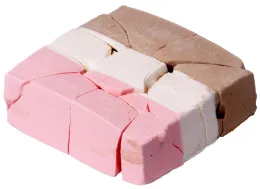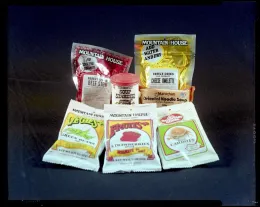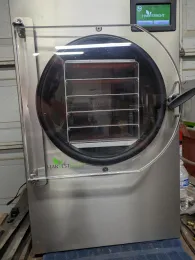Freeze Drying at Home (June 2025)
Tim Long, UC Master Food Preserver Online Program Volunteer
Commercial freeze-dried foods have been around for quite a while.
Astronaut Ice cream for example:

Image credit: Public Domain, 2025.
For those who may be hikers or back packers, as I was while working with Boy Scouts, the commercial freeze-dried meals shown in the image below might be familiar. They are very light weight and tasty.

Image credit: Public Domain, 2025.
HarvestRight, a company in Salt Lake City, Utah, introduced a home use freeze dryer in 2018 which allows us home preservers to make our own freeze-dried foods.

Image credit: Tim Long, 2025.
In early 2023, a second company, Prep4Life, introduced a slightly different freeze dryer for home use known as THE CUBE. A more recent entry in the home freeze dryer market is Blue Alpine, introduced around 2023 or 2024. There is now yet another newcomer manufacturer available known as StayFresh Dryers.
Okay, so what! How does freeze drying work?
The process involves two basic steps
- Step one: Freeze the product to be preserved.
- Step two: Reduce the surrounding air pressure and add a little heat to sublimate the water ice.
In step one, trays of food are placed in the freeze dryer's chamber. The machine freezes the food to a temperature between -30° and -50°F (-34° and -45°C). Next, in step two, a vacuum pump pulls the air out of the chamber to form a vacuum, and the trays are slightly heated. As the frozen water in the food warms, it sublimates (the ice transforms directly from solid to water vapor) and is removed from the product. This process automatically removes up to 98 percent of the water in the food.
So, do I have to tell the machine how to do its job?
All you have to do is make sure to properly prepare the food, make sure the freeze dryer trays are clean/sanitized, place the trays in the machine and follow the directions on the digital panel on the front of the machine. The internal programming takes care of the process i.e., time, temperature, and drying. There’s no guess work.
What happens to microorganisms in the freeze-drying process?
Nothing! The microorganisms stay viable, but dormant, even under the extreme conditions of freeze drying. So please understand that when home freeze drying raw foods the microorganisms in/on those raw foods will remain viable, then potentially reactivate upon rehydration. Food items that are traditionally cooked before eating must also be cooked before eating as a freeze-dried food. Examples are raw meats, raw seafood, raw eggs, and foods containing these raw ingredients.
How do I store my freeze-dried food?
- Place freeze dried food in an airtight container. Otherwise, it will begin to reabsorb moisture from the air and spoil. Suitable packaging includes:
- Mylar bags
- Vacuum sealed plastic bags
- Airtight jars
For a 25-year shelf life, Mylar bags are the easiest and least expensive option. Add an oxygen absorber to make sure oxygen isn’t in your bag, which would degrade your food over time. Then, simply seal the bag with an impulse sealer or even just a hot iron or flatiron.

Image credit: Tim Long, 2025.
- Vacuum sealed plastic bags are another good option for all foods except meat or other high-protein foods.
Simple airtight jars like the one shown below work well for snacks such as fruits, vegetables, yogurt, or even cheesecake and ice cream. These can easily store in a pantry for a few months without adding an oxygen absorber. Just remember to seal the jar tight after you grab your goodies. (The jar shown is a canning jar sealed with a portable jar vacuum sealer.)

Image credit: Tim Long, 2025.
Freeze-dried foods have a number of advantages over conventionally dehydrated foods, as described in the below table.
Freeze Drying | Conventional Dehydration |
| Foods remain similar size or, in some cases (e.g., candies), expand | Foods shrink and develop a leathery feel and appearance |
| Rehydrated foods return to close to original texture and appearance | Rehydrated foods typically don’t return to their original texture or appearance |
| Properly stored freeze-dried foods can have up to a 25-year shelf life | Dehydrated foods have a shelf life of 4 months to 1 year |
| Nearly any food can be freeze dried (see below) | Fewer foods can be successfully dehydrated and rehydrated |
| Foods rehydrate relatively quickly | Foods rehydrate slowly |
Although a freeze-drying unit and a dehydrator both remove moisture from food so that microorganisms cannot grow and enzyme action is slowed down, a dehydrator uses low heat and a fan to remove 80-90 percent of the moisture content from food. In contrast, freeze drying removes up to 98 percent of the water in the food, resulting in a much lower water activity.
What types of food can I freeze dry?
Nearly any food item can be freeze dried:
- fruits,
- vegetables,
- herbs,
- meats (cooked and raw),
- eggs,
- dairy,
- meals,
- casseroles,
- desserts.
So why isn’t freeze drying more popular for home food preservation?
The main impediment to wider adoption of freeze drying at home is the cost; a home freeze dryer still costs a few thousand dollars. In contrast, one can buy a serviceable conventional food dehydrator for a few tens of dollars (though one can spend more). Food dehydrators designed for home use are slowly coming down in price, though, as more manufacturers enter the market. Other impediments to wider adoption of home freeze dryers are their operating and maintenance costs, which are significantly higher than for conventional dehydrators.
Utah State University Extension’s “Preserve the Harvest” recommends that vegetables be blanched prior to freeze drying to prevent discoloration. Food high in fat content, high in sugar content, and baked goods such as breads, cakes, muffins, etc.... do not freeze dry well and should be avoided. Sugar causes food to expand.
Some reference sites used in the preparation of this article are listed below.
- Preserving by Home Freeze Drying, Iowa State University Extension
- Guide to Freeze Drying – The Miracle of Food Preservation, HarvestRight
- Let’s Preserve: Freeze Drying, Penn State Extension
- Freeze Drying, Utah State University
- What Sets The Cube Apart From Other Brands?, Prep4Life
Disclaimer: Reference to any commercial product, process, or service, or the use of any trade, firm, or corporate name is for general informational purposes only and does not constitute an endorsement, recommendation, or certification of any kind. People using such products assume responsibility for their use and should make their own assessment of the information and whether it is suitable for their intended use in accordance with current directions of the manufacturer.
